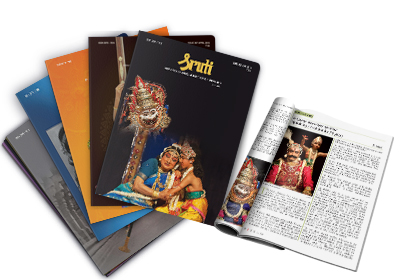The composer of Colletpet

In this sequel to Colletpet Tiger’s lair (see Article Tiger's Lair) Sriram provides proof of Colletpet’s claim to be regarded as a significant ‘sangeeta sthalam’. He discovered from the Gana Manjari, a compilation of the compositions of Veenai Krishnamacharya, the younger brother of Tiger Varadachariar, that most of his compositions are dedicated to this deity. Krishnamacharya’s mudra was ‘Padmapuri Varada’ or minor variants of that term. The book has 12 varnam-s and around 30 compositions, and almost all of them are in praise of either KalyanaVaradaraja or Rama who is enshrined in a sanctum in the same temple complex. Colletpet apparently was also referred to as Padmapuram by the local inhabitants and Krishnamacharya used the name in his songs. Through this article, Sriram corrects his earlier impression tha t Colletpet may not have been sanctified by a musical composition.
Gana Manjari, published in 1966 by Kalakshetra, is a compilation of Krishnamacharya’s songs by Dr. Alamelu Govindarajan and has an introduction by C. Seshachalam, proprietor of Curzon & Co. on Mount Road. He writes that Colletpet played an important role in the musical moulding of Krishnamacharya. According to him, Krishnamacharya’s (and Tiger’s) parents were Uttama Bhagavata Matam Sri Ramanujachariar Swamy who lived with “his good lady who was endowed with an uncommonly high musical talent”. They lived at Kalathur near Tiruvallur. And when Krishnamacharya and his brothers were young, the family migrated to Colletpet which was then “a quiet agraharam, set in a sea of calm acres of swaying and soughing coconut palm groves,” with the temple to Kalyana Varadaraja in its centre. Wonder what happened to all that?
Seshachalam wrote: “As a near-athand tranquil oasis, many of the progressive and prosperous Arya Vysya merchant princes found in Collet Pettah a desirable haven for weekends, away from the noise and bustle of metropolitan Chennapatna. Many were the houses with traditional inner courtyards, sheltered koodams and shady pyols, flowing with holiday hospitality and cultured leisure. The fabulously wealthy Calavala family was prominent in this circle; as also their nephews, my forebears, the not-so-wealthy Chimata Brothers Namberumal, Alavandar and Ramanujam,
familiarly known as ‘Wenlock’ and ‘Curzon’ Chettiars. They were fine connoisseurs and generous devotees of music, which characteristic they obviously inherited from their father, Chimata Krishnaswami Chetty, who for the pure pleasure of it, was cello instructor in Fort St. George!”
Among the Chimata Brothers, Namberumal was a vainika and helped the Tachur Brothers in bringing out their books. It was thanks to him that Krishnamacharya’s musical talents were discovered and he was apprenticed under Pancha Tala Neelakantha Sastry, an expert in the field.
Krishnamacharya was ever grateful to the Chimata family for this and according to Seshachalam,
“almost became a member of the family, always accompanying them on their pilgrimages and picnics also.”
On Krishnamacharya’s compositions Seshachalam wrote that they were “precise, logical, with a carillon purity of welldefined musical syllabification, faithfully and wholly in accord with sampradaya. His varnams are true models of raga forms. They help the students to get a total picture of unerring bold strokes doubtless a broad, sound, sure and safe foundation for later superstructure and embellishment. Specially noteworthy is his varnam in raga Byagada, in that though it is its very life breath, ‘Nishada’ is not pronounced at all. Of course it is intoned. This ingenious, daringly uncommon bold device, is designed to help the practitioner to appreciate nuances, abstracted from the bondage to swara. I wonder if there are any other compositions of this type. I know of no other similar essay.” The varnam is addressed to Kalyana Varadaraja.
Krishnamacharya later settled in Bangalore where he ran the Arya Gana Vidyalaya. He is said to have been proficient in handling a variety of musical instruments also till he suffered a paralytic stroke. In later years he was with Kalakshetra where he set the Kutrala Kuravanji to music. Krishnamacharya passed away in 1947.


